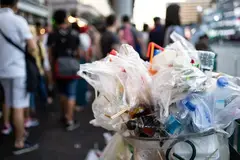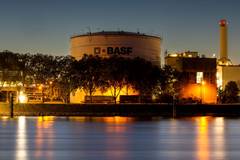Macroplastics dominate river pollution, researchers call for improved packaging design and policy action
A new study has amassed the “largest-ever continuous dataset” on riverine plastic pollution globally and found that 66% of the debris analyzed was macroplastic or large, visible pieces of plastic, such as bottles, bags, straws, and cutlery.
The study, published in the Journal of Environmental Management, draws on a locally led effort to count waste found in rivers across eight countries: Mexico, Jamaica, Panama, Ecuador, Kenya, Vietnam, Thailand, and Indonesia. Between 2020 and 2023, teams removed and analyzed 3.8 million kg of debris, sorting plastic waste by item type, polymer category, and other metrics.
Based on the average plastic collection rates documented in this research, experts at the University of California, Santa Barbara (UCSB), US, estimate 1.95 million metric tons of plastic travel down rivers worldwide annually.
Chase Brewster, a project scientist in UCSB’s Benioff Ocean Science Laboratory, tells Packaging Insights: “Plastic pollution is ubiquitous and heterogeneous. In total, 63% of all the plastic collected was single-use packaging, such as plastic bags, food wrappers, beverage bottles, food, and packaging foam.”
Brewster also tells us about the impact packaging design can have on reducing pollution.“At this point, any reduction in the use of plastic in packaging design is meaningful. Designing products to be reusable or recyclable is critical. Readily recyclable polymers like PET have some value after being used as feedstock for recycled products. Where appropriate infrastructure exists, PET is better managed than typically non-recyclable polymers like low-density PE (LDPE).”
“Designing products that can actually be recycled increases the likelihood that those products are managed and not leaked into the environment. With better design, such as limitations on polymer types and reduced chemical additives, more plastic can become recyclable, giving it value beyond single use and pushing toward closing the loop of a circular economy.”
 Chase Brewster, project scientist in UCSB’s Benioff Ocean Science Laboratory.Measurable policy effect
Chase Brewster, project scientist in UCSB’s Benioff Ocean Science Laboratory.Measurable policy effect
The study underscores the importance of well-designed policies at local, national, and international scales. Based on their findings, the researchers recommend implementing policies such as recycled content targets, bottle deposit schemes, and caps on virgin plastic production to foster a circular economy.
“Of the four study sites where item type data were collected, only Vietnam did not have some sort of plastic bag restriction in the adjacent communities. In Vietnam, 46% of the collected plastic was plastic bags,” shares Brewster.
“In Kenya, Ecuador, and Indonesia, that proportion ranged from 8% to 23%. This suggests that there is a measurable effect of plastic regulating policies on the resulting amounts and compositions of plastic pollution found in adjacent environments.”
“But it [regulation] is not a silver bullet. For example, of the three countries with plastic bag restrictions, the Indonesian policy specifically bans the use of single-use plastic bags in supermarkets. However, the majority of the population in the adjacent communities to the river in the study typically shop at traditional markets — not supermarkets. While in Ecuador, the single-use plastic bag restrictions are much more comprehensive. Twenty-three percent of the plastic collected in Indonesia was single-use bags, compared to 8% in Ecuador.”
Brewster emphasizes that policies should be strategically targeted to maximize impact based on data, for instance, prioritizing a container deposit system for plastic bottles over a plastic bag ban if bottles make up the largest share of environmental plastic pollution, and that such policies should be enforceable.
Informal sector support and investment The researcher says that despite plastic waste being present everywhere, the proportional contribution of the specific item types varied across all study sites (Image credit: TerraCycle Global Foundation).
The researcher says that despite plastic waste being present everywhere, the proportional contribution of the specific item types varied across all study sites (Image credit: TerraCycle Global Foundation).
The scientists say that informal waste pickers should also be supported while expanding waste management and recycling infrastructure. Brewster highlights that based on his data, informal waste pickers play “a vital role in this massive system, and their role should be acknowledged, respected, and formalized.”
“In places like Indonesia, where there is a strong informal waste picking sector, we saw less recyclable plastic ending up in rivers. Typically-recyclable polymers like PET have some sort of value to recoup, and the fraction of PET in the river is far smaller than the polymers without value, such as LDPE, suggesting not that LDPE is more widely used, but that PET is likely already informally managed.”
“This suggests that multipronged action can come together to make an effective solution. From a policy and regulation standpoint, we can help to make more plastic waste have value, for example, recycled content minimums increase demand for recycled plastic feedstock and production streamlines (design, polymers, chemical additives), decrease recycling complexity, and therefore increase the available pool of plastic waste for recycling. The refund values incentivize collection and return.”
The researchers also suggest conducting more consistent and transparent monitoring as well as data collection to inform targeted upstream actions.
“From an infrastructure perspective, we need to increase access to services and scale our systems that are now outmatched by the pace of growth of plastic production and consumption.”
Underpinning the plastic treaty
The research result comes as the UN Intergovernmental Negotiating Committee negotiates the UN Global Plastic Treaty aimed at tackling pollution and promoting global circularity.
 Panama utilizes a dual boom system to stop and remove heavy plastic debris flows that would otherwise end up in the mangroves of Panama Bay (Image credit: Marea Verde).“This is the first on-the-ground data that helps shed light on why plastic is showing up in rivers in the first place, assessing macroplastic debris collected from eight diverse river systems across four continents,” says Brewster.
Panama utilizes a dual boom system to stop and remove heavy plastic debris flows that would otherwise end up in the mangroves of Panama Bay (Image credit: Marea Verde).“This is the first on-the-ground data that helps shed light on why plastic is showing up in rivers in the first place, assessing macroplastic debris collected from eight diverse river systems across four continents,” says Brewster.
He notes that the study provides insights from synchronous three-year community-led research efforts.
“Negotiators and country officials can use this data to assess the river plastic pollution problem in real life, look at differences in pollution in different places, and test ideas about what policies and systems are working.”
“This study finds that it is clear that regular people, our communities, do not want to harm our earth or other people by consuming and dumping plastic — there just is no other choice. The communities that led this research have shown that when they are empowered — when they have tools, information, access, and choices — we can solve this problem. It is up to our governments, corporations, and leaders to join the side of solutions.”
“This work is really about turning off the tap of plastic pollution at its source. It’s not just cleaning rivers. It’s about doing purposeful science and supporting the communities that are the real leaders that will make this change last,” Brewster concludes.











